-
Posts
1,340 -
Joined
-
Last visited
Content Type
Profiles
Forums
Gallery
Events
Posts posted by Thukydides
-
-
Welcome to MSW.
Starting a build log is the first step to success. Starting out can be quite overwhelming, but if you keep at it you will gradually learn the vocab and the skills to succeed.
Treat every step like its own project, this is a marathon not a sprint and I suspect that given you are a similar stage of life to me that you should expect your build time to be measured in years not months :).
- Keith Black, Knocklouder, mtaylor and 1 other
-
 4
4
-
9 minutes ago, druxey said:
I think that, in the real ships, the floors would have been painted canvas. Real inlay would not last well in damp conditions.
So was this canvas essentially like a carpet over the deck planking?
- Keith Black, davec and mtaylor
-
 3
3
-
I really like what you have done with the floor.
- Siggi52, davec, FriedClams and 2 others
-
 5
5
-
That is some really nice clean work.
- mtaylor and mort stoll
-
 2
2
-
Log #72: Tying Off Lines
Thank you to everyone for stopping by and for all the likes.
First off I would like to show off the new tool I made. I discovered that machine sewing needles are better than hand ones for splicing as the hole is closer to the point. So I just made some handles out of spare wood I had lying around. I used standard needles in sizes 70 and 90. The hole on the 70 is not big enough to get whole ropes though, but once you split apart the strands it works better as it is about 0.25mm thinner than the size 90 one. The size 90 one is pictured below.
With all the principal lines in place for the boom and gaff, the next step is to tie them all off. I started with the boom tackle as this one was obvious and has no impact on other lines. I decided to leave a bunch of extra rope in a loose coil after tying it off on the cleat. So step one was to cut the line short and super glue the end to the deck.
I then separately made the coil. I am still playing with the method for making these and will probably give a more detailed explanation of what I do when I am confident I like my process.
For the backstays I belayed them to cleats on the rail and then wrapped extra rope around the base of the block.
I continue to play around with the best way to secure hooks to blocks and I have a new method I am trying out. I arrange the line similar to the previous way of doing it, but I splice the ends into each other and secure it in place with fabric glue.
You can see the end result below seems to look less bulky than my previous attempts.
For the boom toping lift, Goodwin indicates this should be belayed to a pair of single blocks hooked on to the starboard channel. I did a bunch of thinking at this point as I am planning on including the topgalant stays and so wanted to make sure that they would have a place to belay to. In the end I secured the fall to base of the lower block, but then hung the extra on the nearest shroud cleat.
You can see how I used the eyebolt inbetween the last shroud and the standing backstay to leave the sternmost one for the topgallant backstay. My rope coil was not the best, but it looked close enough that I decided to chalk it up as a learning experience. Also being behind the shrouds it is not really that visible.
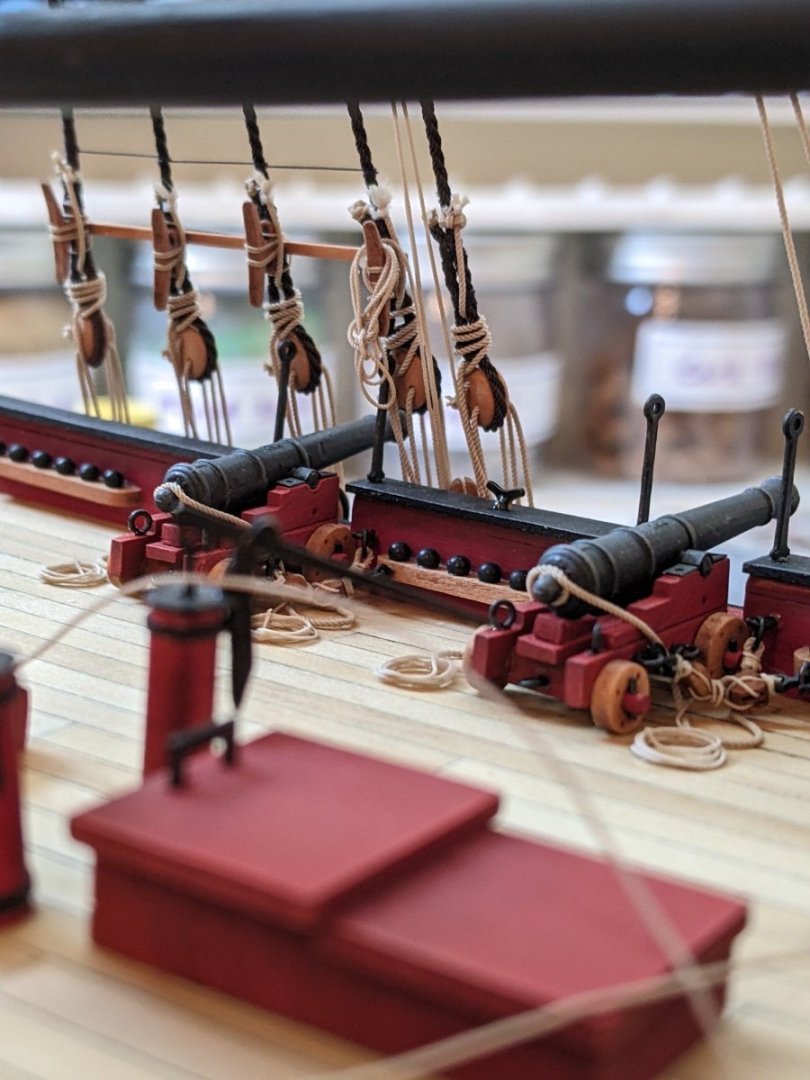
And that brings us up to date. Next I need to secure the inner and outer ties for the gaff and then I will move on to setting up the topgallant.
-
I don’t know how you manage to design and build so many ships so quickly. She is a very interesting looking ship with the drop keels and bow chasers.
- jpalmer1970, AJohnson, chris watton and 4 others
-
 7
7
-
-
26 minutes ago, scrubbyj427 said:
It is certainly possible that some license was used. But I would have to think that a drawing similar to Bristol side profile (ZAZ1749) would have existed for Portland as she was the lead of class, that would have given an accurate example of her carvings and friezes, but who knows, it was 250 years ago that the paintings were made. Who knows what was lost in that time or what is yet to be discovered.
You are right, that is very possible.
At the end of the day even if we think marshall made the decorations up, what do we replace it with. In the absence of other primary evidence I would say what he makes up is more reflective of a likely scheme than anything I could come up with.
- scrubbyj427 and mtaylor
-
 2
2
-
On 2/8/2024 at 8:00 PM, Sizzolo said:
(edit - upon further review I will likely align the plate pattern roughly with the planking rather than overcomplicate with gore-line alignments etc (likely a later period method). If working from waterline-down this makes sense for the period
So will you be tapering th plates to achieve this? I am struggling to visualize how this would work?
-
Fantastic job, she looks lovely. Congrats on having another build done.
Do you have any plans for what you want to do next?
- jpalmer1970 and AJohnson
-
 2
2
-
44 minutes ago, scrubbyj427 said:
Portland paintings this led me to conclude that at some point there was and possibly still is a contemporary model of Portland for which these paintings
I know at least for sphinx the painting was based on perspectives done up by draughtsman based on the plans. Now where Portland was launched prior to the paintings it is possible a model of it existed or that marshall actually saw the ship in question, but it is possible he used some creative license with the decorations.
- scrubbyj427, davec and mtaylor
-
 3
3
-
It is interesting how in the pictures above there are sunk in straps around the whole rudder, but then the pintles are bolted to those straps. Was this a uniquely Dutch thing or was it used elsewhere?
One thing that is unclear to me from all this discussion is if the overlap needs to be such that the lower plates (those closer to the keel) overlap the upper plates (those closer to the waterline), then how do you keep the plates parallel to the keel as practically speaking doing plates from the keel up is not easy due to having to slip the next row under the previous one.
-
57 minutes ago, yvesvidal said:
Thank you, Kevin.
While finishing the lamps, I have a few questions regarding the staff and ensign on these period ships:
- How was the ensign attached to the staff?
- Was the staff equipped with a pulley at the top, to raise the ensign?
Any precision or explanations would be much welcome.
I thank you in advance.
Yves
There is a 1768 contemporary model that shows the attachment for the flag staff, It is hard to tell from the resolution on the RMG site, but there is clearly a loop of rope so there must have been some sort of pully so it could be raised or lowered. I suspect not a full block as they likely would have depicted it if it was, more likely just a metal hoop or maybe a sheeve in the staff itself?
https://www.rmg.co.uk/collections/objects/rmgc-object-66316
https://www.rmg.co.uk/collections/objects/rmgc-object-533928
Edit, actually on second reading it seems the model was made in 1974, so probably not a great source

- mtaylor, John Ruy, jpalmer1970 and 3 others
-
 6
6
-
2 minutes ago, AJohnson said:
Yes, thanks for sharing all these great details. I will be trying to replicate them later this year hopefully on my Trial.
Just as long as you replicate my later versions not the earlier ones
 . Some of them are frankly awful, but this model was meant to be a learning process so by the time I am done hopefully I will somewhat know what I am doing.
. Some of them are frankly awful, but this model was meant to be a learning process so by the time I am done hopefully I will somewhat know what I am doing.
As an update, this is what I have found works the best at this point (an update from my previous post where i detailed my method) is to do as follows:
- Use a needle to pull the whole rope through itself at the starting point.
- Split the pulled through strands into the three segments and use super glue on their ends to make sure they don't unravel.
- Weave each of those ends back and forth through the rope pulling them through with a needle. Ideally you want to weave between the strand not through them, but this is sometimes hard to achieve given the small scales.
- Pull everything tight and while left under tension coat the splice with watered down fabric glue and leave to dry for a few hours.
- Use a fresh blade to cut the ends off and then cover the splice with a watered down coat of matt varnish.
In all stages use the smallest possible sewing needle that will allow you to get the rope or strand through the eye.
-
12 minutes ago, dunnock said:
There is another conundrum relating to the RMG model of Trial. The photos taken by @tkay11 show a second set of sheaves in the main yard. It’s difficult to see, but it looks as if two ropes run through each sheave from a block stopped to the mast cap. I presume that the rope runs to the deck but I can find no reference to this piece of rigging in either Lees, Steel or Marquardt. I added this second set of sheaves when I made the main yard but I can't rig them until I can be sure how it runs.
I am not exactly sure which ones you mean, but if it is the ones I think they are it looks like at least one end is secured to the bits. See below:
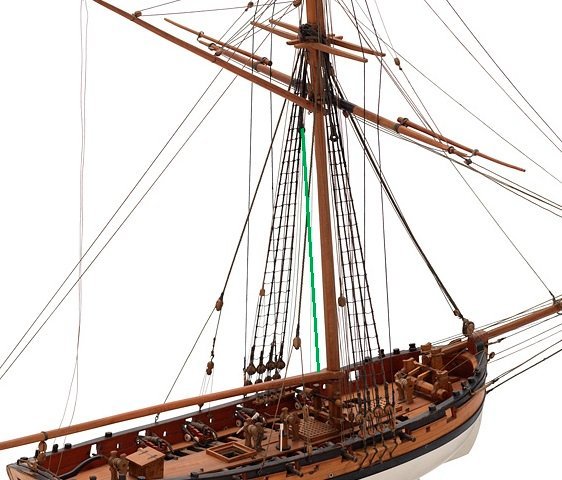
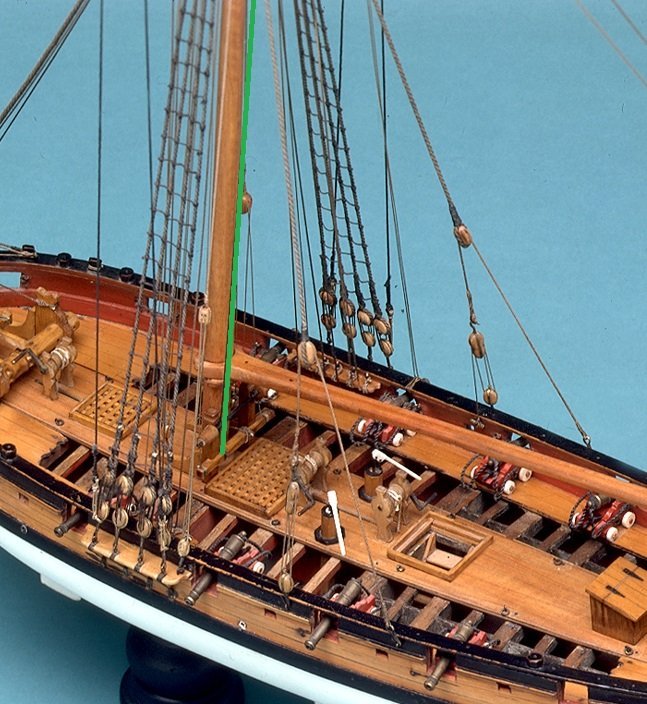
-
She looks fantastic, looking forward to seeing her in the case.
-
Log #71: Raising the Boom
Next up is the boom.
I rigged the block for the boom topping lift in much the same way the other blocks seized to the mast head were done. The main difference is I used a 3.5mm block instead of the 3mm ones. I had wanted to use a 4mm one, but as I have previously discussed, when I went to buy them they were no longer available and so I had to settle for 3.5mm.
I also have been experimenting a bunch with the fake splices and I am slowly getting better at them, though at the same time they are slowly getting closer to a real splice.
According to steel the topping lift should be 4.5 inches cir, this works out to .57mm, but as I didn’t have any 0.6mm rope I instead used 0.5mm.
Counteracting the topping lift we have the sheet tackle. For this I used 0.45mm line copying BE’s arrangement.
For the sheet line I used 0.35mm line. Steel seems to indicate this should be 3 in cir which works out to 0.38 so close enough. I am still having a bit of trouble with the different names between the alert book, steel and the kit instructions, but as there are so many mistakes at this point I am mostly just making sure it makes logical sense and roughly corresponds to steel / the alert book.
And here is the current state of her. Now that all these counteracting lines are in place I need to tie them all off to get rid of the clutter. You can also see I am still working on the tackle for the boom topping lift as the block is spliced onto the line, but is waiting for the glue to dry before I cut off the ends.
Thanks to everyone who has stopped by for the encouragement, she is really starting to look like a sailing ship now.
-
Great tip on the rings, they really do look much more to scale. Amazing work as always.
- mtaylor, FrankWouts, Jack12477 and 3 others
-
 6
6
-
Fantastic, unfortunately there is no way I could ever fit this thing in my house
 .
.
- mtaylor and scrubbyj427
-
 1
1
-
 1
1
-
-
On 2/3/2024 at 10:16 AM, realworkingsailor said:
I have to laugh, you can just hear the Newfanese:
"A lot of people's concern is we don't want it to go back out to sea," he told the Canadian news outlet. "If it goes back out to sea, we're not going to know nothing."I wonder what the editors at the BBC thought of that sentence….
Andy
The funny thing is that is still probably a paraphrase. He likely said
"We're not gonna know nuttin"
They found copper platting and tree nails so likely dates between 1775 and 1850.
-
Looks great, how thick is that tape you are using?
-
-
12 hours ago, TJM said:
Question:
I have a question though: the manual says to use the tiny 0.1 mm natural thread for the ratlines (when I get to that), however, are they not too thin? That would correspond to a rope diameter of only 6.4 mm! It may just me ignorance on my part, but is that not too thin? Using 0.25 mm thread, would correspond to 1.6 cm rope - but is that way too thick?
If you take a look at steel (dated a little later than flirt's launch) https://maritime.org/doc/steel/tables/pages/131-BrigOf160Tons.php it gives the shrouds for the fore mast as 5in cir (0.63mm di at your scale) and the ratlines (on the next page) at 1in cir (0.12mm di at your scale). If you scroll through you will find he also gives the same for the mainmast.
There is also available online an earlier version of steel's tables transcribed https://www.goldenhind.ru/steel_en/dimensions.pdf
However, it does not have as much detail in the 1781 tables and the ship of 14 guns appears to be a ship rigged sloop rather than a brig.

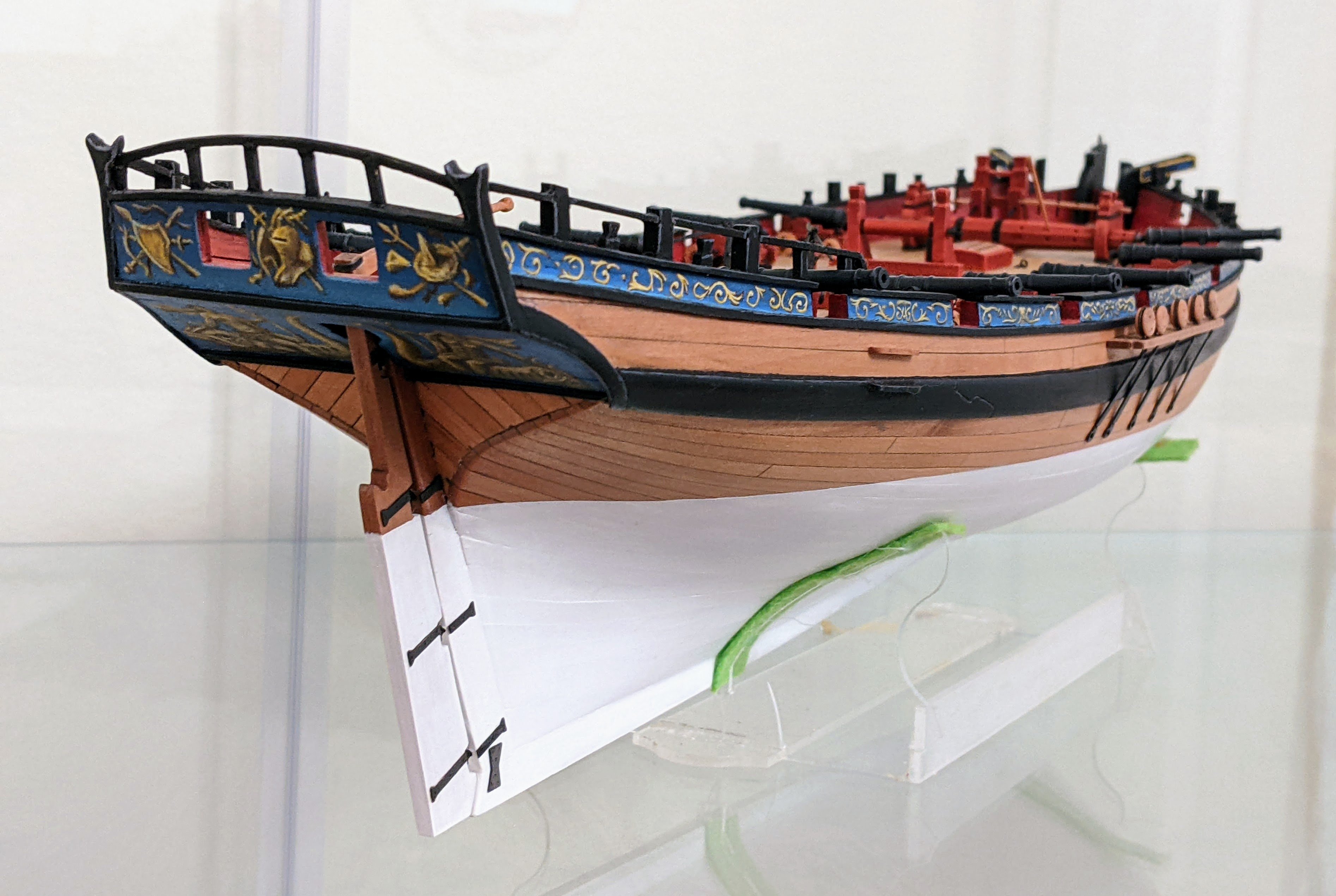


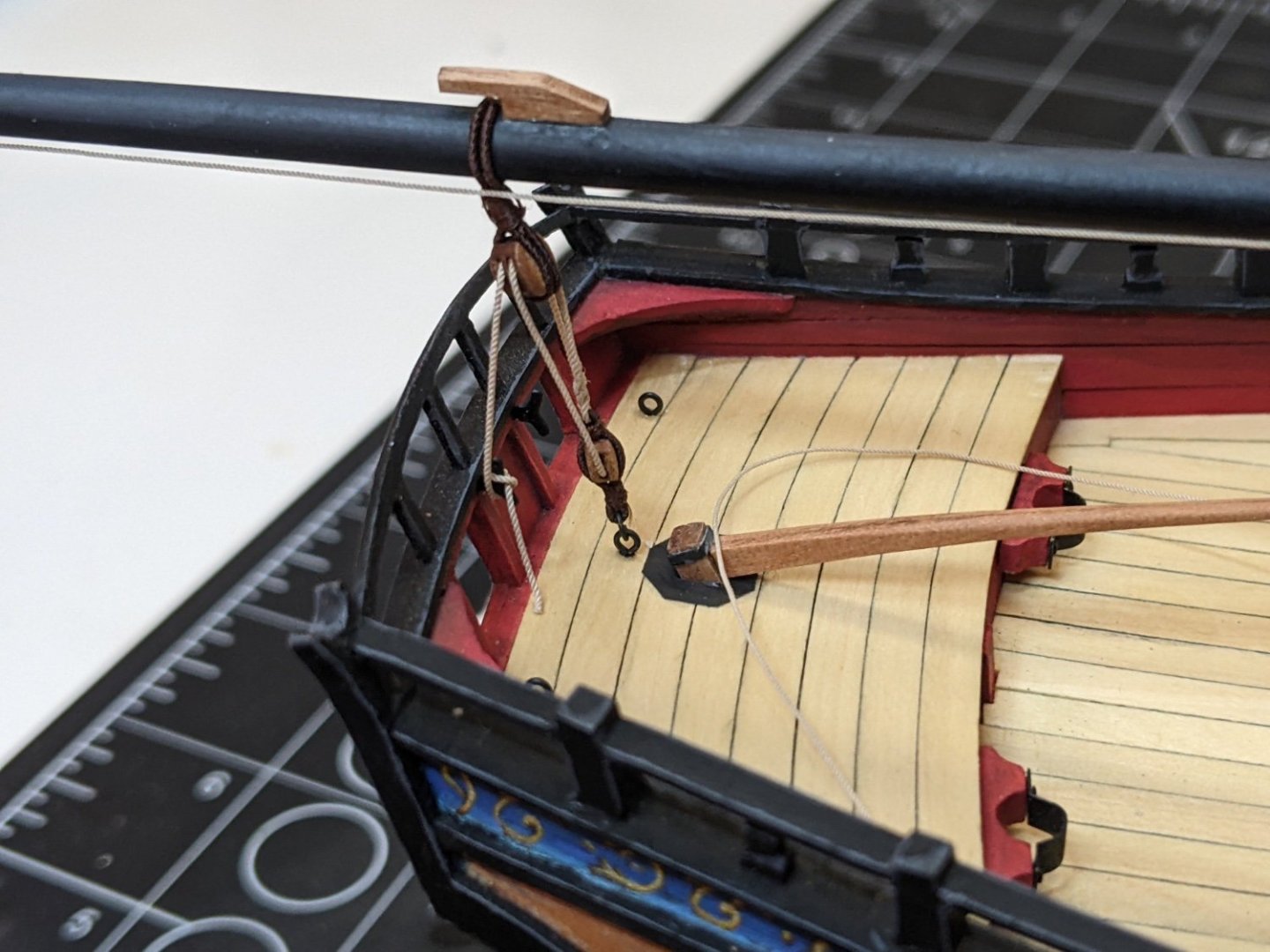
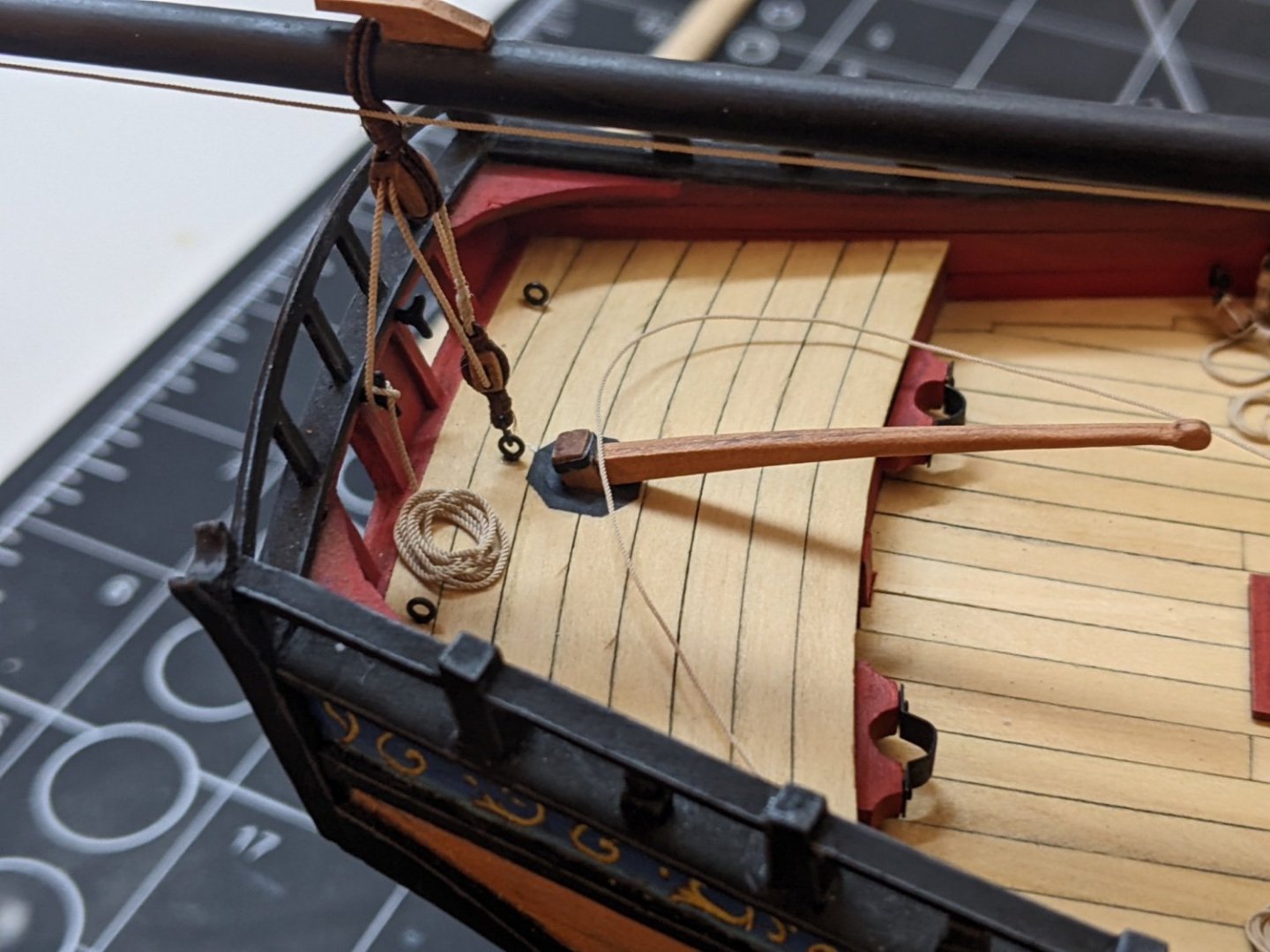
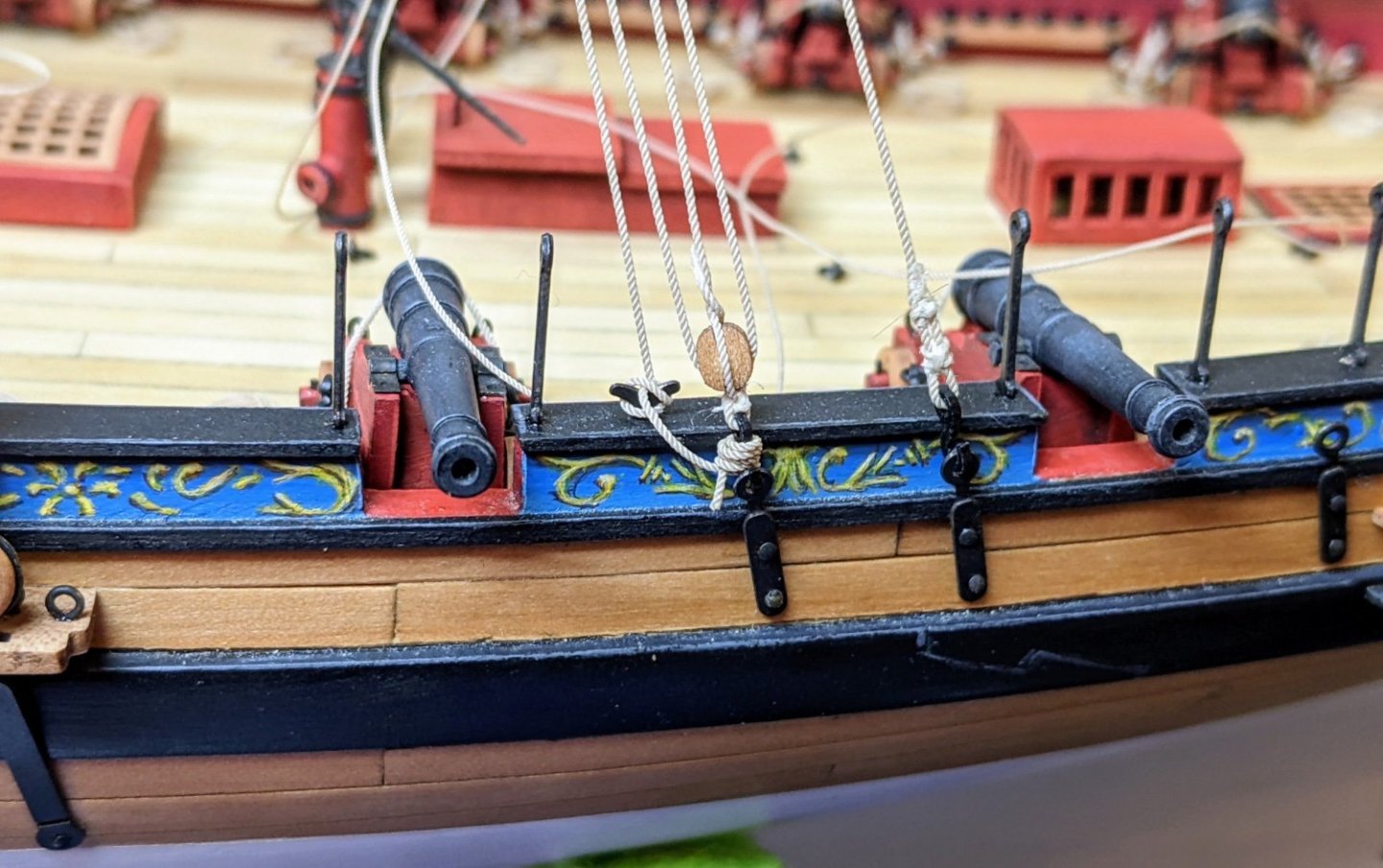
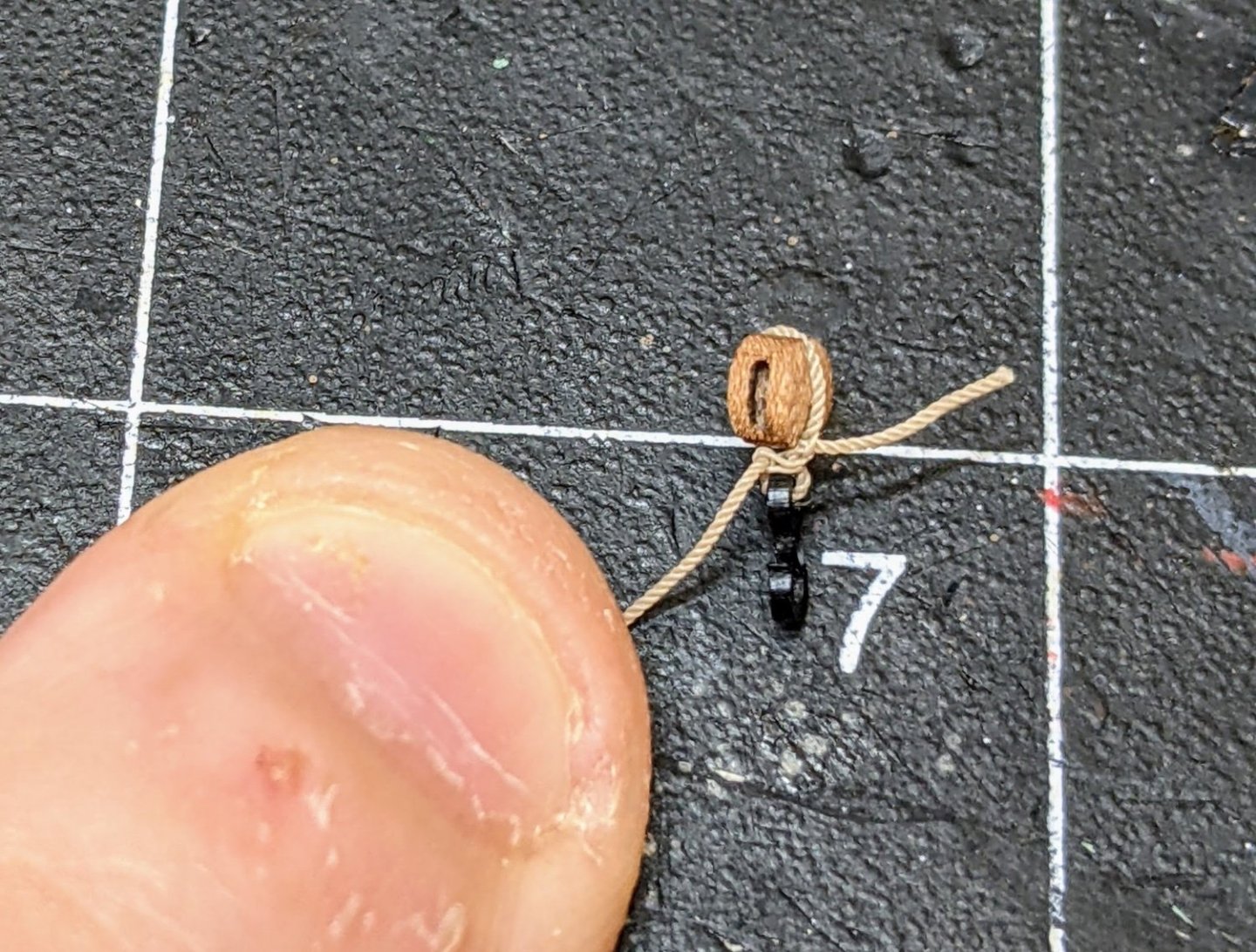
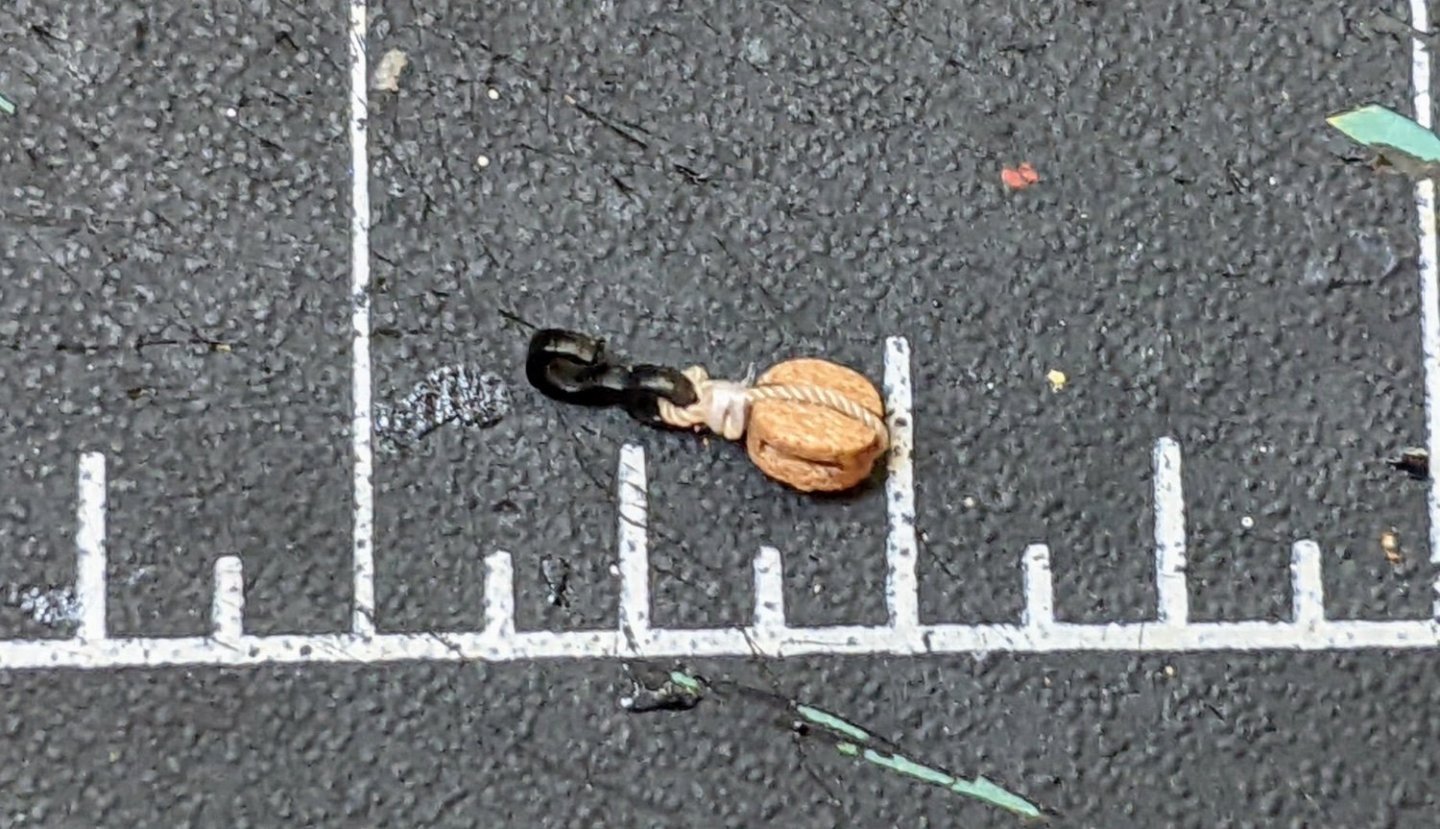
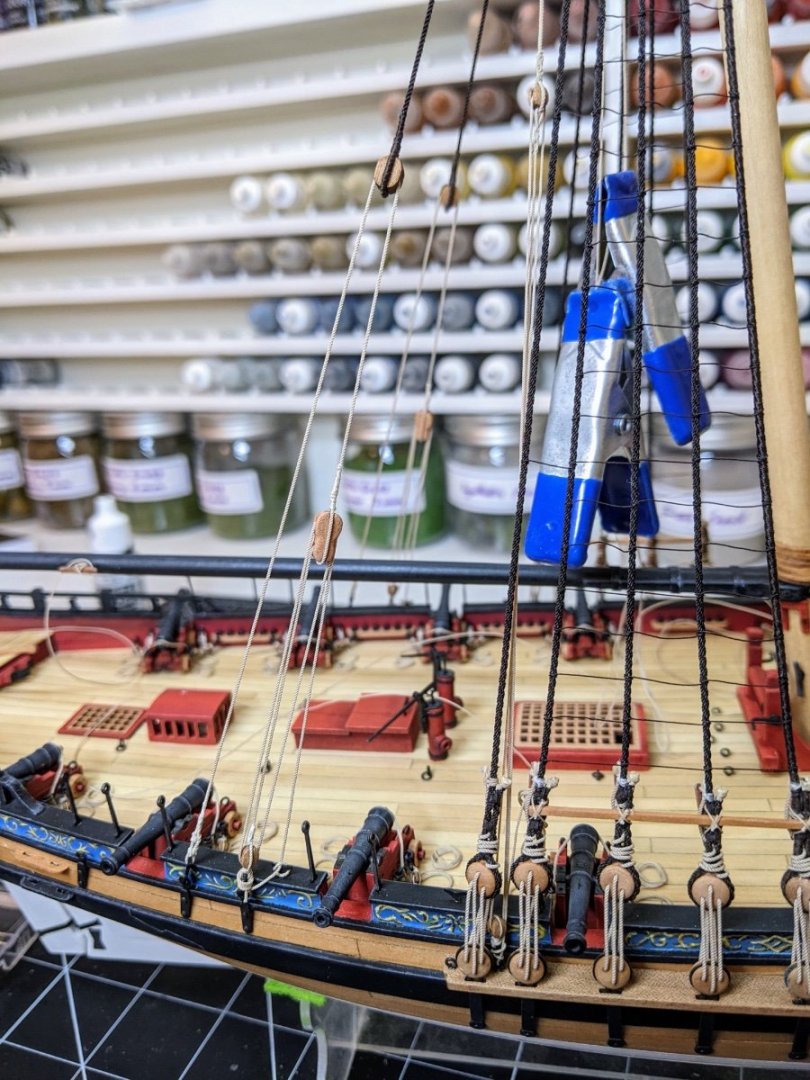
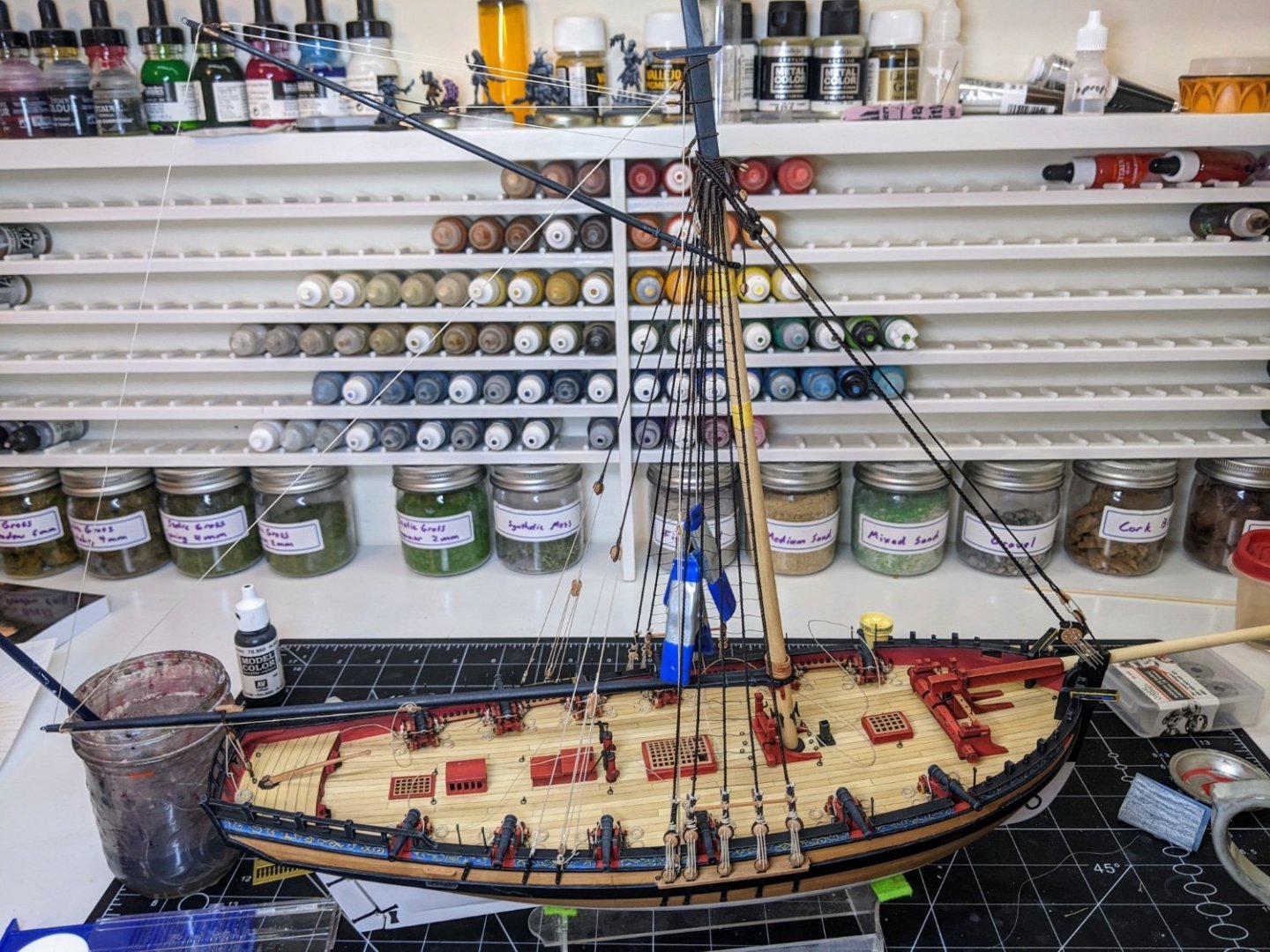







HM Cutter Alert by Thukydides - FINISHED - Vanguard Models - 1:64 - first build
in - Kit build logs for subjects built from 1751 - 1800
Posted
Thanks to everyone for all the encouragement. I am wondering if any of you might be able to offer some advice on my current dilemma.
I have been thinking and have decided I need to figure out what spare apars I will depict. I may need to drape rope coils on top of things and so before things get too cluttered, now would be the time to add the spare spars.
Goodwin lists the following spars/masts in addition to the normal ones.
1) storm topgallant mast
2) storm gaff
3) driver boom
4) mizzen mast
5) outrigger
6) mizzen yard
My questions with regard to this are as follows:
1) would the ship have carried all of these?
2) would they have carried any spares of the regular yard or would they have jurrie rigged something from the above list.
3) would the storm gaff and driver boom have used the same jaws as the regular ones (ie if they needed to swap the boom out they would have attached the jaws to the new one) or did they have their own set permanently attached?
Basically I am trying to figure what of the above list I should depict on the deck.